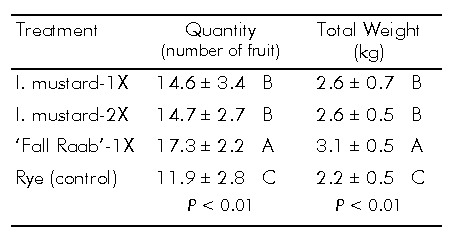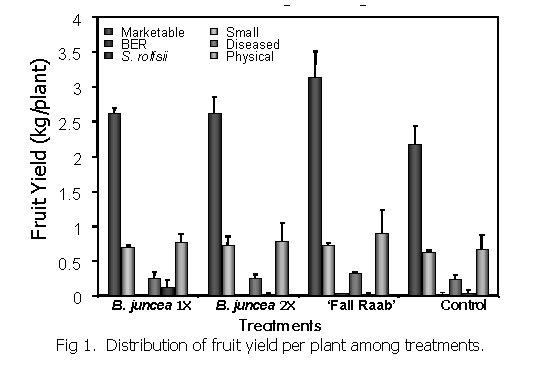Brassica
Biofumigation Increases Marketable Tomato Yield, Knoxville Experiment Station,
2001
Stephanie G. Harvey and Carl E. Sams
Interpretative Summary
The highest tomato yields were produced on plots treated with the ‘Fall Raab’ biofumigation treatment. Plots with Indian mustard incorporated into the soil produced more marketable fruit yield than plots with the rye (control) incorporated into the soil.
Introduction
Fresh market tomato (Lycopersicon esculentum Mill.)
production is economically important in several states including Tennessee.
Traditional cultivation has relied heavily on chemicals for control of
soil pests. With the phase-out of
methyl bromide, alternative commercial practices are needed for control of soil
pests. In addition, there
is increased consumer concern over use of synthetic chemicals in fruit/vegetable
production.
Biofumigation can be defined as the incorporation of biomass into
soil, resulting in the release of toxic volatiles that reduce soil pests.
Other benefits of biofumigation include: improved soil texture, increased
water holding capacity, and improved soil microbial community structure.
The Brassicaceae family is a source of potential biofumigation material.
Family members contain secondary plant metabolites called glucosinolates,
which are believed to be involved in plant defense.
When tissues are damaged, glucosinolates are enzymatically broken down by
myrosinase to produce nitriles, thiocyanates, isothiocyanates and other
products. Isothiocyanates, the predominant breakdown product, have
biocidal activity on fungi (1, 3), bacteria (2) and other pests.
The objectives of this study were to investigate
the potential for biofumigation for use in plasticulture tomato production.
Specifically, we evaluated Indian mustard (Brassica juncea L.) and
Fall Raab (B. rapa L. [Ruvo Group]) as winter cover crops / spring
biofumigation treatments. The
effects on marketable fruit yield and disease were analyzed.
Materials
and Methods
An experiment was preformed with a randomized block design with
split plot treatment assignment. The
whole-plot treatments consisted of three soil pH ranges: 5.2-6.0,
6.5-7.0 and >7.0.
The subplot treatments consisted of the
biofumigation treatments: Indian mustard (PI 458934) sown at commercial
density (1X), Indian mustard sown at twice commercial density (2X), Fall Raab
sown at commercial density and Rye sown at commercial density (control).
The treatments were sown as winter cover crops Sept 1999 and the
resulting biomass was incorporated into the soil May 2000.
‘Celebrity’ tomato plants were transplanted 3 weeks after
incorporation. Harvest data were
collected (per 10 plants). Fruits
were graded by size (Florida scale) and weight and number of fruit were
recorded. Statistical
analysis was preformed on marketable fruit (diameter >6.43 cm; tray sizes
4X5, 5X6 and 6X6).
Results
and Discussion
Biofumigation treatments significantly affected both number
and total weight of marketable fruit (P < 0.01) (Table 1; Fig 1).
The soil pH treatments did not significantly affect number or total
weight of marketable fruit produced (P > 0.05).
There was no significant interaction between pH and biofumigation
treatments (P > 0.05). Due
to its high variability, the cover biomass was analyzed as a covariant and was
not found to significantly effect marketable fruit yield (P > 0.50).
Soil carbon, nitrogen, magnesium, potassium, phosphorus and sulfur were
determined for each plot and analyzed as covariates. These soil nutrients were not found to significantly effect
marketable fruit yields (P > 0.10).
The highest tomato yields were produced on plots treated with the ‘Fall Raab’ biofumigation treatment. Plots with ‘Fall Raab’ incorporated into the soil had 40% more marketable tomato fruit than plots with the rye (control) incorporated into the soil. The ‘Fall Raab’ treated plots also produced 19% more marketable fruit than plots with soil incorporated with the Indian mustard cover crop. Plots with Indian mustard incorporated into the soil produced 18 % more marketable fruit yield than plots with the rye (control) incorporated into the soil.
|
|

|
![]()
 |
Literature
Cited
1. Charron, C. E. and C.E. Sams. 1999. J. Amer. Soc. Hort. Sci. 124: 462-467.
2.
Delaquis, P. J. and G. Mazza. 1995. Food Technol. Nov. 73-84.
3. Harvey and Sams. 2000. Proc. Ann. Intl. Res. Conf. Methyl Bromide Alternatives Emissions Reductions. 92-1